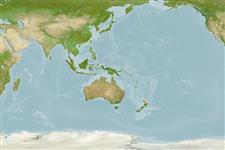Environment: milieu / climate zone / depth range / distribution range
Ecologia
marinhas; estuarina associadas(os) a recifes; intervalo de profundidade 1 - 30 m (Ref. 34095). Subtropical; 25°S - 38°S
Western Pacific: Queensland to Victoria, Australia.
Tamanho / Peso / Idade
Maturity: Lm ? range ? - ? cm
Max length : 15.0 cm TL macho/indeterminado; (Ref. 4690)
Espinhos dorsais (total) : 15 - 16; Raios dorsais (total) : 7 - 9; Espinhos anais: 3; Raios anais : 5; Vértebras: 26 - 27. Presence of a large horizontal spine below the eye, a dorsal fin which originates just behind the posterior edge of the eye, and venomous dorsal spines.
Found in seagrass beds in estuaries (extremely common during reproductive season in the austral Spring) and coastal bays, and sponge gardens on inshore reefs. Venomous dorsal spines often inflict a painful sting to fishers (Ref. 34095, 39597). Of no commercial importance but often entrapped in fishing gears such as trawls and can be dangerous to fishermen who attempt to remove these (Ref. 39597).
Ciclo de vida ou comportamento de acasalamento
Maturities | Reprodução | Spawnings | Egg(s) | Fecundities | Larvas
Paxton, J.R., D.F. Hoese, G.R. Allen and J.E. Hanley, 1989. Pisces. Petromyzontidae to Carangidae. Zoological Catalogue of Australia, Vol. 7. Australian Government Publishing Service, Canberra, 665 p. (Ref. 7300)
Status na Lista Vermelha da UICN (Ref. 130435)
Uso pelos humanos
Ferramentas
Relatórios especiais
Baixar XML
Fontes da internet
Estimates based on models
Preferred temperature (Ref.
123201): 17.6 - 24.2, mean 20.7 °C (based on 105 cells).
Índice de diversidade filogenética (Ref.
82804): PD
50 = 0.6250 [Uniqueness, from 0.5 = low to 2.0 = high].
Bayesian length-weight: a=0.01122 (0.00514 - 0.02450), b=3.04 (2.87 - 3.21), in cm total length, based on all LWR estimates for this body shape (Ref.
93245).
Nível Trófico (Ref.
69278): 3.2 ±0.3 se; based on size and trophs of closest relatives
Resiliência (Ref.
120179): médio(a), tempo mínimo de duplicação da população 1,4 - 4,4 anos (Preliminary K or Fecundity.).
Fishing Vulnerability (Ref.
59153): Low vulnerability (10 of 100).
Nutrients (Ref.
124155): Calcium = 51.7 [17.2, 144.7] mg/100g; Iron = 0.661 [0.315, 1.457] mg/100g; Protein = 18.7 [17.1, 20.2] %; Omega3 = 0.348 [0.142, 0.957] g/100g; Selenium = 10.4 [4.3, 25.7] μg/100g; VitaminA = 104 [31, 354] μg/100g; Zinc = 1.37 [0.86, 2.17] mg/100g (wet weight);
